Dental Bridge Overview
A dental bridge is a restorative treatment used to replace one or more missing teeth. It consists of two or more crowns, known as abutment teeth, which anchor the bridge on either side of the gap. The false tooth or teeth placed in between are called pontics. Dental bridges can be crafted from gold, alloys, porcelain, or a combination of these materials. Abutments can be either natural teeth or implants.
Benefits of a Dental Bridge
A fixed dental bridge serves as an excellent alternative to dental implants, especially when the surrounding teeth are strong enough to support it. The benefits of a dental bridge include:
Maintaining alignment and creating a beautiful smile.
Restoring the ability to chew and speak properly.
Maintaining the shape of your face and supporting the lips and cheeks.
Distributing bite forces properly by replacing missing teeth.
Preventing remaining teeth from drifting out of position.
Our dentist, in collaboration with our master lab technicians, can craft a bridge that matches the color and shape of your surrounding teeth, often enhancing your smile even more than the teeth it replaces.

Procedure for Getting a Dental Bridge
First Visit
Preparation of Abutment Teeth:
At our Lynn Valley office, the abutment teeth on either side of the gap are prepared.
After numbing the teeth and surrounding tissues, the teeth are recontoured by removing a portion of enamel to make room for the crown.
Impressions:
Impressions of the teeth are taken and sent to our partnering dental lab.
A plaster model is created for the fabrication of your dental bridge.
Temporary Bridge:
A temporary bridge is made for you to wear, protecting the exposed teeth and gums while the final bridge is being made.
Second Visit
Removal of Temporary Bridge:
The temporary bridge is removed.
Fitting the New Bridge:
The new porcelain or metal bridge is checked and adjusted to achieve a proper fit.
Multiple visits may be required to check the fit of the metal framework and bite, depending on the individual case.
Caring for Your Dental Bridge
The success and longevity of a dental bridge depend on the solid foundation provided by the abutment teeth.
To ensure this, follow these care tips:
Brushing and Flossing:
Brush twice a day and floss daily to prevent tooth decay and gum disease, which can lead to tooth loss.
Our dental team will demonstrate how to properly brush and floss around the bridge.
Regular Dental Visits:
Maintain a regular cleaning and dental exam schedule to diagnose problems early when treatment is more effective.
Balanced Diet:
Select a balanced diet for proper nutrition to keep your teeth and gums healthy.
By following these guidelines, you can help ensure the longevity and success of your dental bridge.


